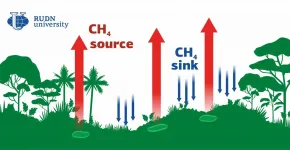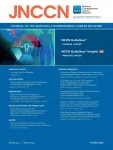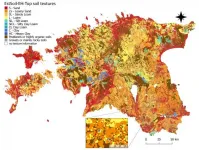RUDN University biologists studied the effect of jungles on global warming
2021-02-16
(Press-News.org) Biologists from RUDN University described the role of tropical rainforests in the production of methane, the second most harmful greenhouse gas after CO2. It turned out that some areas of rainforests not only consumed methane but also emitted it. The results of the study were published in the Forests journal.
Although the share of methane in the atmosphere is relatively small (less than 1%), its contribution to the greenhouse effect is 20 to 30 times bigger than that of the same amount of carbon dioxide. The tropics are one of the main sources of methane. Previously, soil scientists used to focus only on swampy tropical areas, because methane-producing microorganisms live and multiply in the anaerobic conditions of swamps. As for other regions of tropical forests, scientists believed they rather stored methane than emitted it. Still, regular forest soils can also be sources of methane emissions because of small anaerobic pockets in them. Although the intensity of methane production there is lower than in swamp forests, on the global scale, their existence changes our understanding of the climatic impact of rainforests. A soil scientist from RUDN University together with his colleagues traveled to the equatorial rainforests of Ancasa Conservation Area in Ghana to study the role of tropical ecosystems in methane circulation between the soil and the atmosphere.
"We studied two land plots, on top of a hill and at its foot. The plots had opposite conditions and completely different methane production and absorption processes. Our analysis confirmed that equatorial forest soils remain a continuous source of methane all year round," said Riccardo Valentini, a PhD, the head of the Science and Research Laboratory "Smart Technologies for Sustainable Development of the Urban Environment in the Global Change" at RUDN University
The team spent two years monitoring methane flows from and to the soil. The average annual temperature in the area was around 25 ? and annual precipitation amounted to 1,500-2,000 mm with late March to mid-July and September to November being the wettest periods of the year. The measurements were taken in stationary closed clambers using gas chromatography.
According to the team, regions with high levels of methane emissions (both on top of the hill and at its foot) released more methane throughout the year than was absorbed by the soil in drier areas or during the dry season. The plot on top of the hill stored the gas quite slowly and its daily methane flow per square meter varied from absorbing up to 1.29 mg to releasing 0.44 mg of the gas. The lowland plot turned out to be the source of methane emissions. Although in the dry season it stored 0.67 mg per square meter every day, on other days of the year it released up to 188.09 mg.
"The annual methane budget of the soils in Ancasa Conservation Area (adjusted for landscape features) amounts to about 3.3 kg of methane per ha. Our results show that rainforests could be considered sources of methane emissions rather than its storages," added Riccardo Valentini from RUDN University.
INFORMATION:
[Attachments] See images for this press release:

ELSE PRESS RELEASES FROM THIS DATE:
2021-02-16
UCLA RESEARCH ALERT
FINDINGS
A new study led by researchers at the UCLA Jonsson Comprehensive Cancer Center helps identify which patients with prostate cancer will benefit most from the use of prostate-specific membrane antigen PET imaging, PSMA PET, a novel imaging technique that recently was approved by the U.S. Food and Drug Administration.
By studying different variables and risk factors, researchers created a model that can be used in the clinic to identify patients who may have more extensive disease than anticipated and identify patients who are at higher risk of prostate cancer spreading to lymph nodes in the pelvis and beyond. The team found the percent ...
2021-02-16
In today's digital age, the use of "Internet-of-things" (devices embedded with softwares and sensors) has become widespread. These devices include wireless equipment, autonomous machinery, wearable sensors, and security systems. With their intricate structures and properties stems the need to scrutinize them closely to assess their safety and utility and rule out any potential defects. But, at the same time, damage to the device during inspection must be avoided.
Terahertz (THz) imaging, based on radiation with frequencies between 0.1 and 10 THz, is one such non-destructive method that is rapidly gaining popularity owing ...
2021-02-16
PLYMOUTH MEETING, PA [February 16, 2021] -- New research in the February 2021 issue of JNCCN--Journal of the National Comprehensive Cancer Network examined body mass index (BMI) data for people with HER2-positive early breast cancer, and found a 5% weight loss in patients over two years in was associated with worse outcomes. Weight gain over the same time period did not affect survival rates.
"The finding that weight loss, and not weight gain, was associated with worse outcomes is unexpected," said lead researcher Samuel Martel, MD, Universitè de Sherbrooke, Quebec, Canada, who worked with researchers in Belgium, Brazil, Germany, Italy, Switzerland, and the United Kingdom, as well as the ...
2021-02-16
Images provide information - what we can observe with our own eyes enables us to understand. Constantly expanding the field of perception into dimensions that are initially hidden from the naked eye, drives science forward. Today, increasingly powerful microscopes let us see into the cells and tissues of living organisms, into the world of microorganisms as well as into inanimate nature. But even the best microscopes have their limits. "To be able to observe structures and processes down to the nanoscale level and below, we need new methods and technologies," says Dr Silvio Fuchs from the Institute of Optics and Quantum Electronics at the University of Jena. This applies in particular to technological ...
2021-02-16
A recent qualitative study sheds light on how people cope with health and financial challenges, highlighting the important role that communication plays in these coping strategies.
"This is one of the first studies to look at how people respond to the combination of financial uncertainties and health uncertainties," says Lynsey Romo, first author of the study and an associate professor of communication at North Carolina State University. "And it drives home that uncertainty about money and uncertainty about health go hand in hand. Financial limitations created significant health challenges - such as an inability to afford prescription medications. And health problems created significant expenses leading to serious financial challenges.
"The study also highlights that these ...
2021-02-16
A comprehensive database of Estonian soils and a map application has been completed in cooperation with researchers of the University of Tartu and the Estonian University of Life Sciences. The database makes Estonian soil information easily accessible and can be used from local farm-scale to national-level big data statistical analysis and machine-learning models.
"Soil data is possibly the most undervalued and yet complicated type of environmental data there is. The diversity of organic, chemical, living and dead materials that make up a handful of dirt is astounding," said Alexander Kmoch, ...
2021-02-16
BINGHAMTON, NY -- Rich nations should not engage in "vaccine nationalism" and keep the COVID-19 vaccine to themselves when poorer nations need them, according to Nicole Hassoun, professor of philosophy at Binghamton University, State University of New York. Hassoun's paper, "Against Vaccine Nationalism," was published in the Journal of Medical Ethics.
While rich countries like the US and UK are starting to vaccinate their populations against COVID-19, poor countries may lack access to a vaccine for years. Canada, for instance, has already secured enough to vaccinate its entire population nine times over, and the US, European Union, UK, Australia, and Japan can vaccinate their populations between 2-8x.
"Vaccine nationalism ...
2021-02-16
Globalization, digitalization, sustainabilization - three major waves of transformation are unfolding around the world. The social upheaval caused by these transformation processes has given rise to populist movements that endanger social harmony and threaten democratic values. What rules and institutions can promote stability in the face of such systemic risks? A new study published by the Institute for Advanced Sustainability Studies (IASS) offers some surprising answers.
The coronavirus pandemic has demonstrated for the first time how a systemic risk can sweep across our globalized world. It began with the little-noticed outbreak of an unknown ...
2021-02-16
The lithium-ion battery powers everything from mobile phones to laptops to electric vehicles. Scientists worldwide are always on the hunt for new and improved components to build better batteries for these and other applications.
Scientists from the U.S. Department of Energy's (DOE) Argonne National Laboratory report a new electrode design for the lithium-ion battery using the low-cost materials lead as well as carbon. Contributors to this pivotal discovery also include scientists from Northwestern University, Brookhaven National Laboratory and the Ulsan National Institute of Science and Technology (UNIST).
"Our new anode could offer a new revenue stream for the large industry currently engaged in lead-acid battery ...
2021-02-16
By Maria Fernanda Ziegler | Agência FAPESP – The use of cover crops between cotton harvests protects the soil, conserves water, and reduces the risk of erosion. Researchers at the University of Western São Paulo (UNOESTE) and São Paulo State University (UNESP) in Brazil found that application of potassium (K) to a grass cover crop grown before cotton in sandy soil lowered production cost and resulted in cotton with a higher market value.
“The dynamics of early application of potassium to grass planted as a cover crop before cotton ...
LAST 30 PRESS RELEASES:
[Press-News.org] RUDN University biologists studied the effect of jungles on global warming





